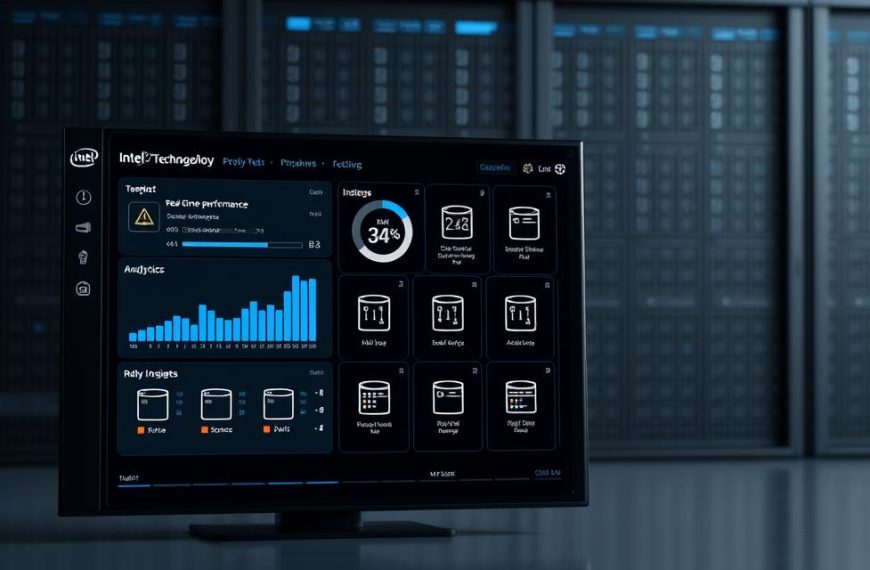In today’s competitive business environment, IT departments must demonstrate value and efficiency, making key performance indicators crucial for measuring and improving IT performance.
IT metrics are quantifiable measurements that help IT leaders manage the business of IT efficiently. A select grouping of these metrics, known as KPIs, are deemed essential to meeting business objectives.
By tracking specific, measurable performance indicators, organisations can gain actionable insights to make informed decisions about their technology infrastructure and investments, ultimately driving success.
Properly implemented KPIs provide a framework for evaluating whether an organisation is meeting its objectives, using data to inform strategic choices.
Understanding KPIs in the IT Landscape
In the realm of Information Technology, understanding Key Performance Indicators (KPIs) is crucial for aligning IT strategies with business objectives. IT KPIs serve as vital signposts that guide organisations in achieving their goals through effective use of technology.
The Definition and Purpose of IT KPIs
IT KPIs are quantifiable measures used to evaluate the performance of IT operations and their impact on business outcomes. The primary purpose of IT KPIs is to provide insights that help organisations make informed decisions, optimise their IT resources, and ultimately drive business success. By focusing on specific metrics that directly relate to strategic objectives, IT KPIs enable organisations to measure progress and adjust their strategies accordingly.
For instance, a KPI might measure how an increase in IT personnel is resolving problems or boosting sales. This is different from a regular metric that might simply track the number of employees hired against a specific goal. IT KPIs are designed to assess the effectiveness of IT operations in achieving desired business outcomes.
How IT KPIs Differ from Regular Metrics
The distinction between a KPI and a metric can be subtle, but it is essential to understand that not all metrics qualify as KPIs. While all KPIs are metrics, regular metrics may simply track operational data without clear business relevance or direct impact on strategic objectives. KPIs, on the other hand, are specifically selected metrics that directly align with and impact business goals.
For example, the number of help desk tickets is a regular IT metric, whereas mean time to resolution and its impact on business productivity is a strategic KPI. Effective IT management requires both comprehensive metrics for operational insight and focused KPIs for strategic alignment and performance measurement.
What is KPI in Information Technology?
In today’s fast-paced IT landscape, KPIs are indispensable for ensuring that technology initiatives are aligned with strategic business goals. When IT metrics are relevant, they guide decision-making that helps companies achieve their strategic goals, focusing the IT team around true drivers of business performance.
Lagging vs Leading KPIs in IT
In IT, KPIs can be categorised into lagging and leading indicators. Lagging KPIs measure the outcomes of past actions, such as system uptime or customer satisfaction scores. In contrast, leading KPIs predict future performance, like the number of ongoing IT projects or the rate of innovation. Understanding the difference between these two types of KPIs is crucial for effective IT strategy and operations.
By leveraging both lagging and leading KPIs, IT leaders can gain a comprehensive view of their department’s performance and make informed decisions about future initiatives.
The Strategic Value of IT KPIs
The strategic value of IT KPIs lies in their ability to align technology initiatives with broader business objectives. Well-designed IT KPIs create a direct line of sight between technical activities and business outcomes, enabling IT leaders to demonstrate the value technology brings to the organisation. By focusing on KPIs that directly support the organisation’s strategic goals, IT teams can ensure that their efforts are contributing to the overall business strategy.
This alignment is critical in today’s IT landscape, where teams are asked to balance increasing business demand with static or decreasing budgets. By using IT KPIs to guide decision-making, organisations can allocate resources more effectively and drive business success.
Why IT KPIs Are Critical for Business Success
Businesses rely heavily on IT KPIs to navigate the complexities of their IT infrastructure and drive growth. In essence, IT KPIs serve as a compass, guiding organisations towards their strategic objectives by measuring performance and progress.
Aligning IT Performance with Business Objectives
IT KPIs are instrumental in aligning IT performance with overarching business objectives. By establishing clear metrics, organisations can ensure that their IT strategies are in lockstep with broader business goals. This alignment is crucial for driving efficiency and improvement across the organisation. Effective IT KPIs enable teams to focus on what matters most, fostering a culture of data-driven decision-making.
- Establishing clear IT KPIs that reflect business objectives
- Ensuring IT strategies are aligned with broader business goals
- Fostering a culture of data-driven decision-making
Data-Driven Decision Making in IT Management
The use of IT KPIs facilitates data-driven decision making in IT management. By leveraging insights derived from IT metrics, organisations can make informed decisions regarding their IT infrastructure and investments. This approach not only enhances management capabilities but also leads to better resource allocation and reduced risk.
As highlighted by industry experts, “You can’t manage what you can’t measure.” Good IT metrics tell a story, providing a fact-based methodology for measuring progress toward business goals. Modern analytics tools and dashboards play a pivotal role in transforming raw IT metrics into actionable insights that support better decision-making at all levels.
By adopting a data-driven approach to IT management, organisations can achieve significant improvement in performance, cost-efficiency, and business alignment. The importance of having clean, reliable data as the foundation for meaningful KPIs cannot be overstated, alongside strategies for ensuring data quality.
Essential Financial IT KPIs
Understanding and leveraging financial KPIs is essential for IT leaders to make informed decisions about technology investments. These metrics provide insights into the financial health and strategic alignment of IT expenditures within an organisation.
IT Spend vs Plan
The “IT Spend vs Plan” KPI compares actual IT expenditures against budgeted amounts. This metric helps organisations assess their financial management and identify areas where costs are deviating from planned expenditures. By tracking this KPI, IT leaders can better manage budgets and make adjustments as needed to stay on track.
Application & Service Total Cost
The “Application & Service Total Cost” KPI encompasses the total cost of ownership for IT applications and services. This includes not only the initial purchase or subscription costs but also ongoing maintenance, support, and upgrade expenses. Understanding these costs is crucial for making informed decisions about application portfolios and service providers.
Percentage of IT Spend on Cloud
The “Percentage of IT Spend on Cloud” KPI measures the proportion of the IT budget allocated to cloud services. This metric is vital for organisations adopting cloud-first strategies, as it helps track progress toward cloud adoption goals. A higher percentage indicates a greater shift toward cloud infrastructure, while a lower percentage may suggest a slower migration pace or a continued reliance on on-premises infrastructure.
To effectively utilise this KPI, organisations should:
- Prioritise cloud migration initiatives to increase cloud spend.
- Validate quick migration wins to support the business case for a cloud-first strategy.
- Break down cloud spend by service type (IaaS, PaaS, SaaS) and provider to gain granular insights into cloud consumption patterns.
| Cloud Service Type | Current Spend | Projected Spend |
|---|---|---|
| IaaS | $100,000 | $150,000 |
| PaaS | $50,000 | $75,000 |
| SaaS | $200,000 | $250,000 |
Key Performance IT KPIs
Key Performance IT KPIs are essential metrics that help organisations evaluate their IT infrastructure’s efficiency. These KPIs provide insights into various aspects of IT performance, enabling data-driven decisions to improve overall system reliability and user experience.
System Uptime and Availability
System uptime and availability are critical KPIs that measure the percentage of time IT systems are operational and accessible to users. High availability is crucial for business continuity, and IT teams strive to achieve 99.99% uptime or higher. This KPI directly impacts user productivity and overall business performance.
Mean Time Between Failures (MTBF)
MTBF measures the average time between system failures, providing insights into the reliability of IT infrastructure. A higher MTBF indicates more reliable systems, reducing downtime and maintenance costs. IT professionals use this KPI to identify areas for improvement and optimise their maintenance schedules.
Network Latency and Response Times
Network latency measures the time it takes for data to travel across the network, significantly impacting user experience and application performance. Lower latency is critical for real-time applications and can be measured in milliseconds (ms). For instance, a latency of 20ms is acceptable for most web applications, while real-time services like video conferencing require latency below 100ms for optimal performance.
| Latency Range (ms) | Application Type | User Experience |
|---|---|---|
| 0-20 | Real-time applications | Excellent |
| 20-50 | Web applications | Good |
| 50-100 | Standard services | Acceptable |
Essential IT Support KPIs
To gauge the effectiveness of their IT support, organisations rely on specific metrics. These Essential IT Support KPIs provide insights into how well IT services meet user needs and expectations.
Mean Time to Repair/Recovery (MTTR)
Mean Time to Repair/Recovery (MTTR) is a critical KPI that measures the average time taken to resolve IT issues. A lower MTTR indicates quicker resolution times, enhancing user satisfaction and reducing downtime. Effective IT support teams strive to minimise MTTR to ensure customer satisfaction and maintain operational continuity.
First Contact Resolution Rate
The First Contact Resolution Rate is another vital KPI, reflecting the percentage of issues resolved during the initial contact with the IT support team. A high First Contact Resolution Rate signifies efficient support and reduces the need for follow-up interactions, improving overall customer experience.
Customer Satisfaction Scores (CSAT)
Customer Satisfaction Scores (CSAT) measure user satisfaction with IT support services, typically collected through surveys or feedback forms. For instance, if the average satisfaction score from 100 user surveys is 4.2 on a scale of 1 to 5, the CSAT would be 84%. CSAT provides a user-centric perspective, complementing technical and operational metrics. It can be broken down by support channel, issue type, and team to identify areas for improvement.
- Tracking CSAT trends over time reveals the impact of process changes and improvement initiatives.
- CSAT directly relates to the perceived value of IT within the organisation.
- Organisations use CSAT to drive continuous improvement in their support services and enhance the overall user experience.
Innovation and Agility IT KPIs
The ability of IT teams to innovate and adapt quickly to changing business needs is a key factor in driving organisational success. In today’s fast-paced technological landscape, it’s crucial for IT departments to measure their innovation and agility effectively.
Percentage of IT Investment on Run, Grow & Transform
Organisations are increasingly adopting the Run, Grow, Transform (RGT) framework to categorise their IT investments. This framework helps in understanding how IT spend is allocated across different areas. ‘Run’ refers to maintaining existing systems, ‘Grow’ focuses on enhancing current capabilities, and ‘Transform’ involves innovation and significant change. By tracking the percentage of IT investment in these categories, organisations can ensure a balanced approach to IT spending.
For instance, a company might allocate 60% of its IT budget to ‘Run’, 30% to ‘Grow’, and 10% to ‘Transform’. This allocation indicates a focus on maintaining stability while also investing in growth and innovation. Adjusting these percentages over can help organisations respond to changing market conditions and business priorities.
Project Lead Time and Delivery Metrics
Project Lead Time and Delivery Metrics are critical for assessing the agility and responsiveness of IT teams. These metrics measure the time taken from the initial request for a new capability to its actual delivery. Key components include concept-to-start time, development cycle time, and deployment frequency.
- Concept-to-start time measures the efficiency of the initial stages of a project.
- Development cycle time assesses how quickly a team can develop a solution.
- Deployment frequency evaluates the regularity of delivering new or updated capabilities.
By tracking these metrics, organisations can identify bottlenecks in their delivery process and make informed decisions to improve their overall agility and delivery capabilities.
Implementing Effective IT KPI Tracking
Effective IT KPI tracking enables organisations to make data-driven decisions and drive continuous improvement. To achieve this, organisations must establish a robust process for tracking and reviewing their IT KPIs.
Data Collection and Integration Best Practices
To track IT KPIs effectively, organisations need to implement best practices for data collection and integration. This involves ensuring that data is accurate, consistent, and accessible across different systems and teams. By leveraging automated data collection tools and integrating data from various sources, organisations can gain a unified view of their IT performance.
Choosing the Right KPI Dashboards and Tools
Selecting the right KPI dashboards and tools is crucial for effective IT KPI tracking. Organisations should look for tools that offer customisable dashboards, real-time data updates, and the ability to drill down into specific metrics. This enables leadership to make informed decisions based on accurate and up-to-date data.
Establishing Regular KPI Review Cadences
Establishing a regular cadence of IT KPI reviews is vital to ensure that they drive action and improvement. This involves scheduling regular review meetings with different stakeholders, including monthly leadership reviews, quarterly business reviews, and annual planning processes. By doing so, organisations can foster a culture of accountability and ensure that IT KPIs are aligned with business objectives.
Regular KPI reviews help organisations identify areas for improvement, address issues promptly, and capitalise on opportunities. This enables management to make data-driven decisions and drive continuous improvement in IT operations.
Real-World Examples of IT KPI Success Stories
Real-world examples demonstrate how the effective implementation of IT KPIs can lead to substantial benefits for organisations. By leveraging IT KPIs, companies can drive significant improvements in their operations, enhance system reliability, and boost user experience.
Cost Optimisation Through Financial KPIs
A retail company utilised cloud cost KPIs to optimise their cloud expenditure, resulting in a 20% reduction in their annual cloud spend. By closely monitoring their cloud usage and costs, they were able to identify areas of inefficiency and implement corrective measures.
Improved Support Quality Through Service KPIs
A healthcare organisation focused on improving their IT support quality by tracking First Contact Resolution Rate and Customer Satisfaction Scores (CSAT). This led to a 15% increase in first contact resolutions and a 10% improvement in customer satisfaction.
Enhanced Performance Through Technical KPIs
A manufacturing firm leveraged technical IT KPIs, such as Mean Time Between Failures (MTBF), to enhance their system performance. By implementing proactive maintenance procedures, they achieved a 30% reduction in unplanned downtime, significantly improving their operational efficiency.
- A healthcare organisation improved system uptime by 10% and reduced application response times by 25% through comprehensive performance monitoring.
- A retail company used network latency KPIs to identify and address infrastructure bottlenecks, enhancing customer-facing application performance.
- A manufacturing firm reduced unplanned downtime by over 30% by leveraging MTBF metrics and implementing proactive maintenance.
Conclusion: Maximising the Value of Your IT KPIs
To maximise the value of their IT investments, organisations must focus on implementing and monitoring the right KPIs. The effectiveness of IT KPIs lies not just in their measurement, but in how organisations use these insights to drive continuous improvement in business performance.
By focusing on key metrics related to IT cost, support, and performance, businesses can make data-driven decisions that align with their strategic goals. A balanced approach across different types of KPIs – financial, performance, support, and innovation – provides a comprehensive view of IT effectiveness.
Regular review and adjustment of KPIs are crucial to ensure they remain relevant and valuable in an ever-changing technological landscape. Organisations should prioritise customer satisfaction and identify areas for improvement when selecting and monitoring their KPIs.
By doing so, they can optimise costs, improve service quality, enhance system performance, and ultimately deliver greater business value in today’s technology-driven marketplace. To achieve success, organisations should start small, focus on quality over quantity, and ensure stakeholder buy-in when implementing or enhancing their IT KPI tracking.
By following these guidelines and maintaining a focus on the right metrics, organisations can maximise the value of their IT KPIs and drive long-term business success.




















